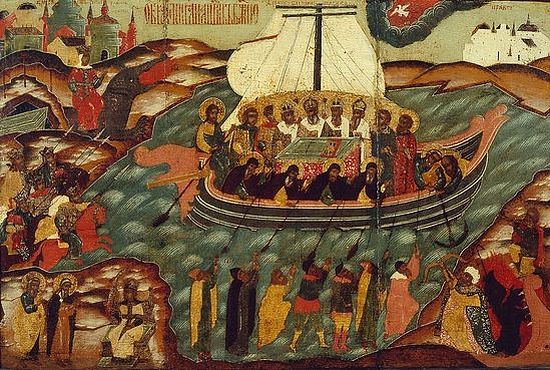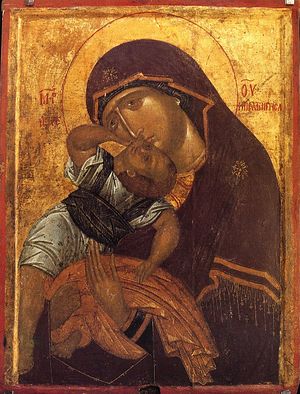From the book of sermons and conversations with Serbian Patriarch Pavle Walk to Eternity: Selected Sermons and Interviews published by Sretensky Monastery.
***
The day following Jesus would go forth into Galilee, and findeth Philip, and saith unto him, Follow me. Now Philip was of Bethsaida, the city of Andrew and Peter. Philip findeth Nathanael, and saith unto him, We have found him, of whom Moses in the law, and the prophets, did write, Jesus of Nazareth, the son of Joseph. And Nathanael said unto him, Can there any good thing come out of Nazareth? Philip saith unto him, Come and see. Jesus saw Nathanael coming to him, and saith of him, Behold an Israelite indeed, in whom is no guile! Nathanael saith unto him, Whence knowest thou me? Jesus answered and said unto him, Before that Philip called thee, when thou wast under the fig tree, I saw thee. Nathanael answered and saith unto him, Rabbi, thou art the Son of God; thou art the King of Israel. Jesus answered and said unto him, Because I said unto thee, I saw thee under the fig tree, believest thou? thou shalt see greater things than these. And he saith unto him, Verily, verily, I say unto you, Hereafter ye shall see heaven open, and the angels of God ascending and descending upon the Son of man.
John 1:43-51
In the name of the Father and of the Son and of the Holy Spirit. Today, brothers and sisters, we are celebrating the first Sunday of the holy and honorable Great Lent, which is known as the Sunday of Orthodoxy. In the ninth century, in 852, when Orthodoxy defeated Iconoclasm, it was decided that this Sunday would be the feast of the Triumph of Orthodoxy.
You know, there were kings, and bishops, and other people who believed that icons were not befitting of the Orthodox Church. Perhaps these bishops and kings wanted to remove the icons from the Church to easily attract Muslims, who had no icons, and Jews to Christianity. Meanwhile, brothers and sisters, there were icons in the Church from the very beginning. Truly, in the Old Testament, among the Ten Divine Commandments the Lord commanded, Thou shalt not make thee any graven image, or any likeness of any thing that is in heaven above, or that is in the earth beneath, or that is in the waters beneath the earth: Thou shalt not bow down thyself unto them, nor serve them (Deut. 5:8-9). But the Lord also said not to make any kind of images, or idols, for you did not see God appear. What does this mean? St. John Damascene says it’s meaning is clear. When you will see God in the flesh, then you will be able to make icons. This is why after the birth, passion, and Resurrection of the Son of God the Church of God began to make icons and venerate them. We, brothers and sisters, according to St. Basil, do not bow down to the material, or the paint, or the gold, or the silver, or the metal that is on the icon, but to the person whom the icon depicts. Also, like all of you, we do not toss out a photograph of our father or mother, but put them in a visible place, because it bears the image of our parent (and it’s important for us)—so, all the more important is it when we’re talking about the face of God and His saints.
Let the holy icons remind you about it: glorifying them, we must also try to enter into the glory of the Kingdom of God, to be and become His sons and daughters, to enter into the blessedness of this Kingdom and be holy. This is why we have icons in our churches and homes. They remind us of our holy ancestors and of all Orthodox, of the times when people of flesh and blood like us, by their labor and with God’s help, were able to make their souls worthy of grace and to become true citizens of Heaven. We can and must do this, if we want. Otherwise, if we don’t want this, we make our soul unworthy of the Kingdom of God, and we kill it, and we have to be ready for eternal torment, for such is our choice. There, in the Orthodox Church, icons depict those persons who were able to become heavenly.
And you know, in the modern world, especially in the Catholic Church, icons, in essence, as portraits of people of this world, both men and women, are very beautiful. But there is too much of this world in them, too much of the earthly body. These icons depict people, but it is more like people of hell than Paradise. This is what I want to say: if you look at a western icon of El Greco for example, or any of the other great western painters, you will see a woman with the charms of this world, while on the beautiful Pelagonitissa icon of the Most Holy Theotokos with the Child in her hands from Decani, which has traveled throughout the world (and I consider it the best icon I have ever seen), the Most Holy Theotokos with her Son the Lord Jesus is presented as a Virgin before, during, and after the birth of the Lord. She, alone of all the generations of this world is chosen to be the mother of the Son of God due to her virtues, to her spiritual purity and holiness, just as it says in the Psalter: The king's daughter is all glorious within (Ps. 44:14). And this inner beauty, is in the face and in the whole form of the Most Holy Theotokos, and in all the saints.
We have to be able to distinguish an icon before which it’s possible to pray from icons which call upon this world, before which it’s impossible to pray, as one of the great Russian theologians said. In his time as an atheist, he went to the Sistine Chapel and marveled at the beauty of Raphael’s Madonna, in the work of this artist. But, having become a believer, and then a priest, an archpriest, and a great theologian, after his second visit to the Sistine Chapel and meeting with this icon, he wrote and said, “I cannot pray before this picture. We see a beautiful woman in it, walking along the clouds as through the snow, and carrying a child, and she, perhaps, is not an innocent maiden. I cannot pray.” Do you understand what he’s talking about? An icon must present an historical figure—the Lord Jesus, the Most Holy Theotokos, or a saint—but a heavenly person. In the words of Christ: Where I am, there shall also my servant be (Jn. 12:26). And where is the Lord? In the Heavenly Kingdom. That means we prepare ourselves for the Heavenly Kingdom, for the blessedness of the Kingdom now, in this world. It is the one thing needful (Lk 10:42), as the Lord says to Martha in His conversation in her home. We must achieve this. Of course, we do not despise the body, nor this world, but our true Fatherland and our true life is in the Heavenly Kingdom.
May the Lord help us to pass through this Lent so that afterwards we would be incomparably better and healthier in soul and body, than before. May the Lord bless you and bestow all blessings.
I beseech you, keep this Lent, even if you have oil and fish, but leave the meat for Pascha. In the words of St. Basil the Great: Water is all the more delicious after thirst, and food is all the more delicious after hunger; so, in abstaining from non-fasting food, it will be all the more delicious for us, and our bodies will be that much better able to use it.
God bless you!



